Are you the proud owner of a Dodge Challenger, but recently noticed the check engine light illuminating on your dashboard? Don’t panic, as this is a common issue faced by car owners. While it can be frustrating and confusing to deal with, this guide will help you troubleshoot and fix the check engine light on your Dodge Challenger.

Understanding the Check Engine Light
Before diving into the troubleshooting process, it’s important to understand what the check engine light means. This light is an indicator that something is wrong with your car’s engine, emissions system, or other vital components. It’s not a specific diagnosis, but rather a general warning sign that alerts the driver that there is an issue that needs to be addressed.

Checking the OBD-II Codes
The first step in troubleshooting the check engine light on your Dodge Challenger is to retrieve the OBD-II codes. These codes provide a clue as to what the problem could be, and can be retrieved using an OBD-II scanner or code reader. Simply plug the scanner into the OBD-II port, typically located under the steering wheel, and follow the instructions to retrieve the codes.
Identifying the Problem
Once you have the OBD-II codes, it’s time to identify the problem. While some codes can be straightforward, others may require further diagnosis. Here are some common issues that may trigger the check engine light on your Dodge Challenger:
- Faulty oxygen sensor
- Loose or damaged gas cap
- Malfunctioning catalytic converter
- Failed ignition coil
- Faulty mass air flow sensor
- Broken vacuum hose
Fixing the Problem
Once you’ve identified the problem, it’s time to fix it. Depending on the issue, this can range from a simple DIY fix to a more complex repair. Here are some possible solutions to common issues:
- Oxygen sensor: Replace the faulty sensor.
- Gas cap: Tighten the cap or replace it if damaged.
- Catalytic converter: Replace the converter if malfunctioning.
- Ignition coil: Replace the failed coil.
- Mass air flow sensor: Clean or replace the sensor.
- Vacuum hose: Replace the broken hose.
Preventing Future Issues
To prevent the check engine light from illuminating in the future, it’s important to properly maintain your Dodge Challenger. Here are some tips:
- Follow the manufacturer’s recommended maintenance schedule.
- Regularly check and replace air filters and spark plugs.
- Use high-quality fuel and oil.
- Keep tires properly inflated and aligned.
Conclusion
Dealing with the check engine light on your Dodge Challenger can be stressful, but with this guide, you should be able to troubleshoot and fix the issue. Remember to properly maintain your car to prevent future issues from occurring.
Additionally, if you’re experiencing other symptoms such as rough idling or decreased performance, it’s important to have your car checked by a mechanic. Ignoring these symptoms can lead to further damage and a more costly repair bill.
In conclusion, while the check engine light on your Dodge Challenger may be alarming, it’s important to remain calm and follow the troubleshooting steps outlined in this guide. By identifying and fixing the problem, as well as properly maintaining your car, you can keep your Dodge Challenger running smoothly for years to come. Remember to always address any issues promptly and seek professional help if necessary.

Why is my check engine light flashing?
A flashing check engine light indicates a serious problem that requires immediate attention.
Can I ignore the check engine light?
While the car may still function, ignoring the check engine light can lead to further damage and costly repairs.
How much does it cost to fix the check engine light on a Dodge Challenger?
The cost of repairs will depend on the issue and the extent of the damage. Simple fixes like replacing a gas cap can cost as little as $20, while more complex repairs can cost upwards of $1,000.
Can I still drive my car with the check engine light on?
While the car may still function, it’s important to address the issue as soon as possible to prevent further damage and costly repairs.
How often should I check my car’s OBD-II codes?
It’s recommended to check your car’s OBD-II codes at least once a year or whenever the check engine light illuminates on your dashboard. This can help you catch potential issues early on and prevent further damage.

